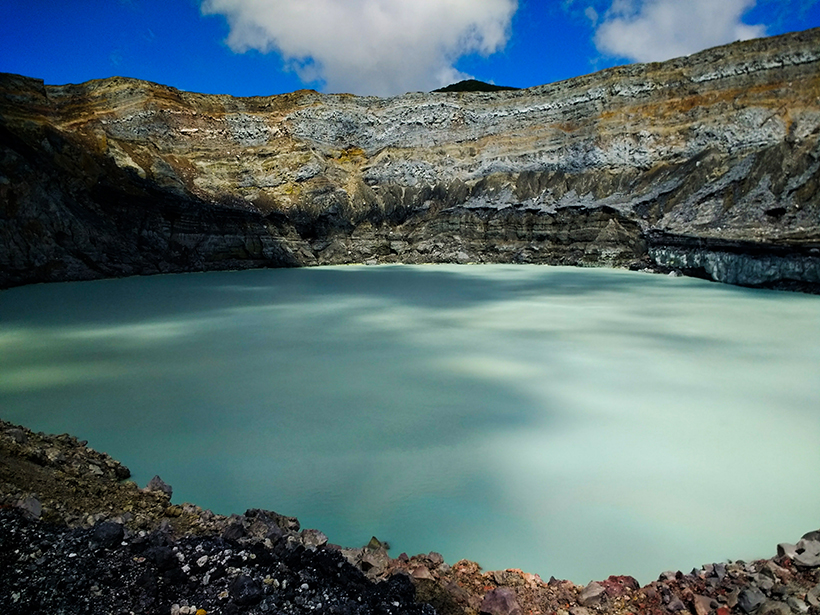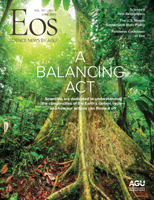In subduction zones, where one tectonic plate sinks below another into our planet’s mantle, carbon, water, and other volatile species like hydrogen and sulfur move between the surface and the deep Earth. Scientists quantify this cycling of elements by estimating how much of each is subducted with downgoing slabs and how much is emitted by volcanic arcs, the chains of volcanoes that form on the upper plate overlying a subducting plate. Taking stock of carbon cycling is especially important, because the process influences the amount of carbon dioxide in the atmosphere and, ultimately, the long-term stability of Earth’s climate.
Previous research has constrained such carbon fluxes from volcanic-arc regions around the world, including in Central America [e.g., de Moor et al., 2017]. But fluxes in fore arcs and back arcs—the areas on either side of volcanic arcs—remain poorly understood [Füri et al., 2010], and carbon in these areas may be modified by or consumed by such secondary processes as mineral precipitation or microbial activity near the surface [Venturi et al., 2017]. Recent studies have also highlighted the importance of an extensive global subsurface microbial biosphere, which may play significant roles in altering Earth’s biogeochemical cycles [Magnabosco et al., 2018].
Our current understanding of subduction, from a geochemical perspective, largely neglects the role of biology in the upper plate. This is partly because of disciplinary boundaries that often confine researchers to their specific fields of expertise. To improve our understanding of subduction and the fate of carbon in a holistic way, an international group of early-career scientists launched a research initiative in 2016 that brought together a large multidisciplinary team to study the Costa Rica convergent margin (Figure 1). Funded by the Alfred P. Sloan Foundation and under the umbrella of the Deep Carbon Observatory, the Biology Meets Subduction project is a novel scientific effort to help understand the intimate relationships between the geosphere and the biosphere at a convergent margin.

Costa Rica Field Campaigns
The Biology Meets Subduction project seeks to answer four scientific questions: What is the influence of biological activity on carbon outgassing at the Costa Rica convergent margin? Can biological signatures be traced through subduction processes and distinguished from surface biological activity by using isotopic data? By using this information, can we better constrain carbon sources and fluxes? And can we improve deep-carbon budget estimates for the Costa Rica convergent margin?
In addressing these specific questions, the project, which is in the data analysis stage, has the potential to improve global carbon flux estimates by describing a major and previously overlooked role of the deep microbial biosphere in geological processes.
The Costa Rica convergent margin has a large, well-studied fore arc that is subaerially exposed, presenting the opportunity to track volatiles like carbon.
The Costa Rica convergent margin has a large, well-studied fore arc that is subaerially exposed, presenting the opportunity to track volatiles like carbon across this important part of the margin. In February 2017 and April 2018, a team of researchers from six nations convened in Central America to conduct two field expeditions across and along the volcanic arc in Costa Rica and Panama. Members of each of the four Deep Carbon Observatory science communities (Deep Energy, Deep Life, Reservoirs and Fluxes, and Extreme Physics and Chemistry) participated.
In total, the team sampled 50 geothermal sites across the region, gathering hundreds of individual samples of gases, fluids, sediments, and rocks. To link biogeochemical processes, the team collected samples from hydrothermal springs with a wide range of both temperature (23°C–89°C) and pH (0.8–10.8) that were simultaneously analyzed for gas geochemistry, aqueous chemistry, mineralogy, and microbiology. The researchers tracked and distinguished surface-derived carbon (arising from processes like photosynthesis) from deeply sourced carbon by analyzing the isotopic compositions of different carbon pools (such as dissolved inorganic carbon, dissolved organic carbon, gaseous carbon dioxide, and total organic carbon) as well as by analyzing helium isotope data.
A Subsurface Sink
Early results from the expeditions revealed a previously unrecognized sink for volatiles in the fore arc of the Costa Rica margin [Barry et al., 2019a; Barry et al., 2019b]. Carbon isotope compositions of deep hydrothermal waters rising toward the surface showed a clear Rayleigh distillation (the selective partitioning of isotopes between two reservoirs as material moves between them) resulting from calcite precipitation in the fore arc. This precipitation accounts for the removal of 91% of the inorganic carbon in these fluids that are rising from the top of the subducting slab. An additional 3% of this inorganic carbon, in the form of outgassing carbon dioxide, was sequestered as biomass by chemolithoautotrophic microbes (i.e., microbes that produce biomass from carbon dioxide in the absence of light), which might also actively mediate calcite deposition [Aloisi et al., 2006]. Calcite and microbial biomass therefore act as subsurface filters for fore-arc carbon, altering the fluxes that would otherwise be released directly to the atmosphere.
By using the data collected during the 2017 expedition, Barry et al. [2019a] also calculated that as much as about 19% less carbon is transported into the mantle with subducting plates than was thought from previous estimates. This has significant implications for the accuracy of global carbon models, which might be overestimating carbon exportation to the deep Earth, and for our understanding of Earth’s past climate and reduction-oxidation conditions. For example, the authors suggested that fore-arc carbon sinks that are similar to the one identified in the Costa Rica margin might have contributed to the accumulation of oxygen during the late Archean and early Proterozoic and should thus be considered when modeling the effects of subduction zones on carbon cycling through deep time.
Linking Geology and Biology
The Biology Meets Subduction team is currently analyzing the microbial functional diversity and the taxonomic diversity of the samples collected (K. M. Fullerton et al., Plate tectonics drive deep biosphere microbial community composition, EarthArXiv, https://doi.org/10.31223/osf.io/gyr7n). Results of this work will provide insights into connections between microbial metabolism and volatile cycling in the Costa Rica margin, as well as insights into links between tectonic processes and microbial community compositions and functions.
This project represents a unique opportunity to link the effect of biology to large-scale geological processes and will help clarify the role of biology in influencing volatile cycling at convergent margins.
This information will help explain microbial connections to deep-subsurface processes, a topic that has recently been explored in hot springs elsewhere in the world, including at Yellowstone National Park and in New Zealand [Colman et al., 2019; Power et al., 2018]. Overall, this project represents a unique opportunity to link the effect of biology to large-scale geological processes and will help clarify the role of biology in influencing volatile cycling at convergent margins.
The early results from the project raise questions about the role of secondary processes acting to sequester carbon and volatiles in other tectonic environments, like back-arc regions, continental rifts, and fold and thrust belts. Investigating these environments opens interesting opportunities to further study the complex interplay between the geosphere and the biosphere that has maintained our planet’s habitability for billions of years.
Acknowledgments
We thank the many collaborators on this project and all the team members who took part in the field campaigns. The Biology Meets Subduction project was funded by the Alfred P. Sloan Foundation and the Deep Carbon Observatory (grant G-2016-7206).
References
Aloisi, G., et al. (2006), Nucleation of calcium carbonate on bacterial nanoglobules, Geology, 34(12), 1,017–1,020, https://doi.org/10.1130/G22986A.1.
Barry, P. H., et al. (2019a), Forearc carbon sink reduces long-term volatile recycling into the mantle, Nature, 568(7753), 487–492, https://doi.org/10.1038/s41586-019-1131-5.
Barry, P. H., et al. (2019b), Helium, inorganic and organic carbon isotopes of fluids and gases across the Costa Rica convergent margin, Sci. Data, 6, 284, https://doi.org/10.1038/s41597-019-0302-4.
Colman, D. R., M. R. Lindsay, and E. S. Boyd (2019), Mixing of meteoric and geothermal fluids supports hyperdiverse chemosynthetic hydrothermal communities, Nat. Commun., 10(1), 681, https://doi.org/10.1038/s41467-019-08499-1.
de Moor, J. M., et al. (2017), A new sulfur and carbon degassing inventory for the Southern Central American Volcanic Arc: The importance of accurate time‐series data sets and possible tectonic processes responsible for temporal variations in arc‐scale volatile emissions, Geochem. Geophys. Geosyst., 18(12), 4,437–4,468, https://doi.org/10.1002/2017GC007141.
Füri, E., et al. (2010), Carbon release from submarine seeps at the Costa Rica fore arc: Implications for the volatile cycle at the Central America convergent margin, Geochem. Geophys. Geosyst., 11(4), Q04S21, https://doi.org/10.1029/2009GC002810.
Magnabosco, C., et al. (2018), The biomass and biodiversity of the continental subsurface, Nat. Geosci., 11(10), 707–717, https://doi.org/10.1038/s41561-018-0221-6.
Power, J. F., et al. (2018), Microbial biogeography of 925 geothermal springs in New Zealand, Nat. Commun., 9(1), 2876, https://doi.org/10.1038/s41467-018-05020-y.
Venturi, S., et al. (2017), Fractionation processes affecting the stable carbon isotope signature of thermal waters from hydrothermal/volcanic systems: The examples of Campi Flegrei and Vulcano Island (southern Italy), J. Volcanol. Geotherm. Res., 345, 46–57, https://doi.org/10.1016/j.jvolgeores.2017.08.001.
Author Information
Donato Giovannelli ([email protected]), Department of Biology, University of Naples Federico II, Naples, Italy; Peter H. Barry, Woods Hole Oceanographic Institution, Woods Hole, Mass.; J. Maarten de Moor, Observatorio Vulcanológico y Sismológico de Costa Rica (OVSICORI), Universidad Nacional de Costa Rica, Heredia; also at University of New Mexico, Albuquerque; Karen G. Lloyd, University of Tennessee, Knoxville; and Matthew O. Schrenk, Michigan State University, East Lansing
Citation:
Giovannelli, D., P. H. Barry, J. M. de Moor, K. G. Lloyd, and M. O. Schrenk (2020), Microbial influences on subduction zone carbon cycling, Eos, 101, https://doi.org/10.1029/2020EO140906. Published on 03 March 2020.
Text © 2020. The authors. CC BY 3.0
Except where otherwise noted, images are subject to copyright. Any reuse without express permission from the copyright owner is prohibited.


